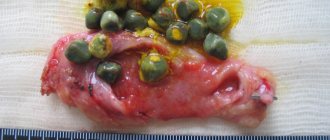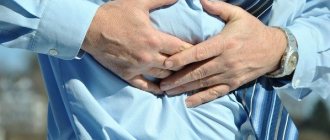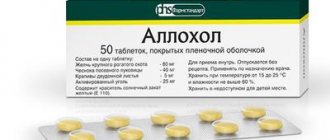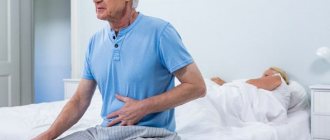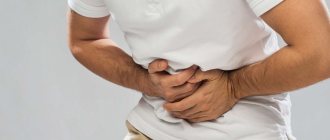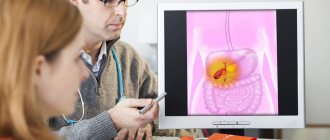This site was made by experts: toxicologists, narcologists, hepatologists. Strictly scientific. Tested experimentally.
Author of this article, expert: toxicologist, candidate of sciences Stanislav Radchenko
In short: A gallbladder constriction in an infant is usually corrected immediately with surgery. For adults, conservative treatment is used: choleretic drugs and diet. Deformation of the gallbladder sometimes turns out to be an ultrasound error: as soon as a person changes his body position, everything becomes normal.
- Why an ultrasound may show constriction, kinking or narrowing of an organ
- Symptoms of gallbladder deformation
- Diagnostics
- Treatment of gallbladder deformity
- How to eat properly if you have a deformed gallbladder
- What to do if a child’s gallbladder is bent
- Symptoms and causes of kinks
- How to treat a bent gallbladder in children
- What can you eat
- Prevention
- The story of how, when the gallbladder was bent, diet turned out to be more important than pills
- How abdominal pain forced me to go to the doctors
- What we saw on ultrasound and CT
- How the doctor found a solution to the problem
This article was checked and edited by Candidate of Medical Sciences, toxicologist Stanislav Radchenko.
Why an ultrasound may show constriction, kinking or narrowing of an organ
The gallbladder consists of three sections: neck, body, and fundus. In the absence of an anomaly, the human gallbladder has a funnel- or pear-shaped shape. Deformation may occur in any of the departments - permanent or temporary. A narrowing in diameter is often called a constriction, and deformation on only one side is called a kink.
For any type of deformation, its origin is fundamental. Deformations that look the same on ultrasound can be the result of intrauterine development anomalies (congenital defect in the structure of the gallbladder), or purely functional changes in the tone and location of the organ, which can change even with changes in body position.
Types of kinks of the gallbladder.
Deformation of the gallbladder becomes a problem only in a situation where it indicates inflammatory changes, precedes or accompanies a violation of the outflow of bile, or is a consequence of already developed complications of cholecystitis.
If the problem is detected at an early age and has clinical manifestations in the form of certain digestive disorders, it is dealt with surgically. Constriction of the gallbladder in a small child is a pathology, which in some cases can be corrected immediately after birth.
Years later, developmental anomalies can be distinguished from transient changes only during dynamic observation. Treatment methods remain the same: through diet and medications, the flow of bile is improved.
Advice to a sick person from gastroenterologist Daniela Purgina, an expert on the website Pokhmelye.rf.
Nothing stimulates gallbladder motility like regular nutrition. Therefore, try not to skip meals.
Deformation of the gallbladder can be provoked by various factors associated with both an abnormal development of the organ and the consequences of an unhealthy lifestyle. The most common of them:
- Inflammatory processes in the gallbladder. This may be chronic or acute cholecystitis. The deformation in this case turns out to be a consequence of the adhesive process, which tightens the lumen of the bladder. How to find out if you have this disease - read the article about the symptoms of chronic cholecystitis.
- Incorrect position of internal organs or their rise/fall, for example, due to rapid weight loss or the development of ascites.
- Lifting heavy objects or other significant simultaneous load. Mechanical stress on the body can cause the gallbladder to “twist”. A similar condition occurs in older people without any significant stress, but then it goes away on its own.
- Poor nutrition. Prolonged fasting, followed by abundant nutrition, leads to stagnation of the contents, either with small or with significant volumes of the bladder.
- Eating against a background of strong emotions. Severe nervous excitement with abundant nutrition leads to a delay in the secretion of bile. It does not have time to exit into the intestines and accumulates in the bladder. Over time, this can lead to constriction.
- Gallstones. Changes in the size and shape of stones provoke the formation of kinks and constrictions.
Read answers to questions about gallbladder deformity that our expert hepatologist often asks. Your question may already be answered!
In the conclusions of ultrasound diagnostic specialists, the abnormal shape of the gallbladder in children is very common. At the same time, some attending physicians pay little attention to such conclusions, considering them not so important and having no clinical significance. Others have a number of questions. Let's figure out what AFLD is, what other anomalies of the gallbladder and ducts are found, and what significance they have for the clinician.
Essence of the question
Currently, interest in developmental anomalies of both the biliary tract and other organs and systems, and the frequency of their detection, have increased significantly. This is primarily due to the widespread use in clinical practice of modern diagnostic methods, which together make it possible to establish the anatomical and topographical features of various parts of the biliary tract.
The identification of developmental anomalies in various parts of the biliary system is associated with the question of their clinical significance, as well as their possible role in the formation of diseases of both the biliary tract itself and other organs of the gastrointestinal tract.
Anomalies of the biliary tract are congenital defects and malformations, often causing functional disorders with the subsequent development of inflammatory changes and the formation of stones.
Anomalies in the development of the gallbladder include several groups of pathological conditions:
- anomalies of shape (kinks, septa, gallbladder in the form of a Phrygian cap and bull's horn, hook-shaped, S-shaped (see picture), etc.);
- position anomalies (intrahepatic, interposition, inversion, dystopia, rotation);
- quantity anomalies (agenesis, accessory or duplicated gallbladder, diverticula);
- size anomalies (hypogenesis, giant gallbladder).
Anomalies of the bile ducts include:
- atresia of the bile ducts (extrahepatic and intrahepatic);
- hypoplasia of interlobular intrahepatic bile ducts;
- cysts of the common bile duct and multiple cystic dilatations of the intrahepatic bile ducts (Caroly's disease);
- abnormalities of the cystic duct (elongated cystic duct, change in the level of confluence, hypoplasia and fibrosis of the cystic duct, absence of the cystic duct);
- accessory bile ducts.
Several factors play a role in the development of abnormalities. One of them is genetic. Based on the study of family clinical and anamnestic data, assumptions are made about a dominant mechanism of inheritance with different gene expression in two generations. According to morphological studies, changes in the state of nerve endings in the mucous membrane were found, which confirms the congenital nature. Of particular importance is the congenital underdevelopment of muscle fibers of the biliary tract and the disproportion in the growth of the gallbladder and its bed in childhood.
Acquired gallbladder deformities are associated with pericholecystitis. Bends and constrictions appear due to the formation of adhesions and adhesions that fix the gallbladder to neighboring organs.
In clinical practice, it is not always possible to unambiguously answer the question of whether deformities are acquired or a consequence of a developmental anomaly.
In the vast majority of cases (in every fifth healthy child), anomalies in the development of the biliary tract do not have clinical manifestations and are discovered accidentally during diagnostic studies or during preventive measures.
However, some anomalies may manifest as an acute abdomen, for example, a wandering gallbladder due to circulatory problems (mesenteric torsion, compression by neighboring organs), which requires emergency surgical care.
Developmental anomalies are divided into minor and major (MAR and BAR, respectively). MAD includes minor deformations of the gallbladder. In children with bipolar disorder, there is pronounced stagnation of bile, and biliary sludge, microconcretions and even stones of significant size can also be detected.
It should be noted that pediatricians pay little attention to biliary sludge or are not sufficiently informed about its clinical significance, although it is considered the initial stage of cholelithiasis (GSD). According to studies, every fifth child with biliary sludge subsequently develops gallstones.
There are three main types of biliary sludge:
- echoheterogeneous bile with clots,
- a suspension of hyperechoic particles,
- putty-like bile.
In clinical practice, the most common variant of biliary sludge is in the form of a suspension of hyperechoic particles (approximately 70%), the detection frequency of the other two variants is about 10–12%.
In recent years, stones in the gall bladder and/or bile ducts have become more common. A characteristic feature is that in every second child the disease develops against the background of various anomalies in the development of the gallbladder and bile ducts.
Congestion in the gallbladder over time leads to dystrophic processes in the wall and disruption of its contractile function, up to atony.
There is evidence of a connection between abnormalities in the development of the biliary tract and chronic liver diseases in children. After all, a violation of the passage of bile and its stagnation in the bladder cannot but affect the functional state of the organ.
Considering the anatomical and topographical relationship of the common bile duct and the Wirsung duct, it is logical to assume that with anomalies of the bile ducts, a violation of the outflow of pancreatic secretions is possible. In such cases, a change in the activity of the gland occurs, up to the development of exocrine insufficiency.
In 90% of children with developmental anomalies, echographic changes in the pancreas are detected in the form of an increase in the size of the tail, body, head, increased or decreased echogenicity of the organ tissue, blurred contour, etc.
The presence of kinks, constrictions, membranes, cysts in the biliary tract interferes with bile secretion and can lead to disruption of the enterohepatic circulation of bile acids, causing impaired absorption of lipids and fat-soluble vitamins. In the future, the development of maldigestion is possible.
Clinical practice
At Polyclinic No. 7 in Grodno, we perform ultrasound of the abdominal organs both in children with complaints of various types, and for preventive purposes. The study protocol includes examination of the gallbladder and ducts. Polypositional scanning is required: lying on your back, lying on your side and standing.
According to our observations, pathology of the biliary tract is the most common (up to 80% of cases). The vast majority of patients at the appointment have an abnormal shape of the gallbladder (about 40%), often with congestion (10%), and stones of various sizes are also encountered (1%).
The main complaints are of periodic abdominal pain, less often of nausea, vomiting, and bad breath. Also at the reception, parents report the presence of a bend in the gallbladder in themselves or their closest relatives.
It has been noted that gallbladder pathology is accompanied by changes in the pancreas (13%) in the form of an increase in size and/or increased echogenicity of its tissue, however, these disorders are recorded with severe deformations accompanied by stagnation of bile.
Stagnation of bile, or biliary sludge, in children is visualized as a suspension of hyperechoic particles; other options are extremely rare. Stones are detected regardless of age (even in patients under 3 years of age).
Ultrasound is one of the main methods for diagnosing developmental anomalies and acquired deformations of the gallbladder; at the same time, this study is not always informative in diagnosing anomalies of the ductal system.
Drawing. S-shaped gallbladder. Ultrasound results.
A more reliable picture of the anatomical and topographic relationships of the biliary tract and their anomalies is provided by the use of radiological methods (endoscopic retrograde cholangiopancreatography, CT).
Objective data on the structural features of the hepatobiliary system can be obtained by MRI, non-contrast magnetic resonance cholangiopancreatography, and dynamic contrast enhancement.
Conclusion. Many variants of developmental anomalies of the biliary tract do not manifest themselves in any way and have no clinical significance, however, there are anomalies that can make a significant contribution to the pathogenesis of diseases of both the biliary system itself and other organs (liver, pancreas, esophagus, stomach and intestines), aggravate their course, contribute to an unfavorable outcome.
Symptoms of gallbladder deformation
Most often, deformation of the gallbladder is not accompanied by changes in well-being. Moreover, in approximately half of the cases, the ultrasound conclusion about the “bending” and “constriction” of the gallbladder is the result, if not of imagination, then, in any case, of the hyperdiagnostic attitude of the ultrasound doctor. It may be sufficient to change the position of the patient’s body on the couch or take a deep breath, sticking out the stomach, so that the corresponding ultrasound symptom disappears.
An ordinary person can suspect the presence of a real problem, which is accompanied by deformation of the gallbladder, only by deviations in health:
- Digestive disorders are nonspecific and are similar to the manifestations of symptoms of food poisoning or microbial damage to the gastrointestinal tract. The patient is plagued by constant nausea. It can be triggered by anything, from fatty foods to physical activity. Following nausea, vomiting appears. It develops against the background of an inflammatory process in the gallbladder, stomach and duodenum.
- A deformed gallbladder may be accompanied by abdominal pain. The main location is the right hypochondrium (but can also be in the area around the navel). This process is associated with stretching of the walls of the gallbladder and (or) duodenitis. Due to blockage or stones entering the ducts, the pain increases significantly. Symptoms can manifest themselves sequentially: from small manifestations to large ones. This means that one factor provokes the development of another - and so on increasingly.
- In the case of bile peritonitis, intoxication leads to headaches, general weakness and increased body temperature. The pain syndrome gradually covers the entire surface of the abdomen, its intensity is significant, but not extreme, as in the case of pancreatic necrosis. The lack of bile in the intestines leads to a change in the color of stool: it becomes light. When the described symptoms appear, the optimal tactic is to call an ambulance (“033” from a mobile phone, “03” from a landline).
Pain can be a symptom not only of organ deformation, but also of other, more serious pathologies. Read the article about how the gallbladder hurts in various diseases and how to treat pain in the gallbladder.
Simple ultrasound diagnosis of the gallbladder
Ultrasound of the liver and biliary tract is performed using external sensors on the anterior abdominal wall. The patient needs to lie on his back and remove clothing from the upper abdomen. After this, the doctor applies a special water-soluble gel to the sensor in order to eliminate the air gap upon contact with the skin and facilitate the passage of ultrasonic waves. If the bottom of the bile ducts is covered with intestinal loops, the doctor will ask the patient to take a deep breath and hold his breath for as long as possible, or turn over on left side. To identify pathological inclusions in the biliary tract (sand, stones), the patient may be asked to stand and bend forward several times. Preparation for an ultrasound of the liver and biliary tract must be carried out without fail.
Diagnostics
The main way to detect gallbladder deformation is to perform an ultrasound. In some cases, it allows you to evaluate not only the shape and size, but also the performance of the gallbladder. However, finding out the actual causes of deformation is not so easy. Even comprehensive diagnostic measures do not guarantee that difficulties can be avoided.
To determine the congenital or acquired nature of the deformity, a test with choleretic agents can be performed: for example, with egg yolks. If the constriction is congenital, the shape of the bladder on ultrasound will not change after taking choleretic drugs.
Sonographic signs of deformation reveal the presence of linear formations with different localizations. They can be determined by performing a transverse scan. The constriction is often fixed at the junction of the body and the neck. The bile located in the bladder has the appearance of an echo-negative formation. The study reveals the degree of dyskinesia, which is present in 80% of cases.
Treatment of gallbladder deformity
If a congenital or acquired constriction does not manifest itself clinically, a person can live with this anomaly all his life. For adults, surgery is rarely prescribed. If symptoms of digestive disorders are present, treatment is usually conservative:
- Gastroenterologists give preference to choleretic drugs and procedures: for example, probe intubation of the duodenum - the so-called tubage. The dosage is selected by the doctor during dynamic observation. (Attention: tubing is a specific medical procedure, and not the so-called “liver cleansing”, which is an amateur activity of people ignorant in medicine and can cause harm to the body. Read the article, which analyzes the types of liver cleansing from a scientific point of view.)
- As with other digestive system disorders, diet is of particular importance. Its main goal is to normalize the outflow of bile with a general reduction in the need for it.
An expert on the website Pokhmelye.rf, gastroenterologist Daniela Purgina, warns against a common mistake.
Do not try to get rid of the constriction using medications. It's ineffective. Changes in the shape of the gallbladder cannot be treated with medication.
Basic principles of the diet for constriction or kinking of the gallbladder:
- The list of restrictions includes easily digestible carbohydrates (except honey), fats, smoked foods, spicy foods, and fried foods.
- It is allowed to eat stewed and boiled vegetables.
- It is better to avoid raw foods: to prevent additional irritation of the inflamed mucous membrane of the esophagus, stomach, and small intestine.
- Fermented milk products with moderate acidity (for example, kumiss is not suitable) in moderate quantities are not contraindicated.
How dangerous is the disease?
Gallbladder torsion threatens the patient with long-term consequences in the form of the following health problems:
- decreased quality of the digestive system;
- deformation and dystrophic changes in the compressed tissues of the organ itself;
- formation of cracks in the mucous membrane of the gallbladder and in its deeper tissues;
- poor circulation, which in the future will lead to the gradual death of cells deprived of blood supply;
- throwing of bile into the peritoneal cavity due to its disrupted outflow process.
If a gallbladder bend is detected, treatment should begin immediately after diagnosis. The more precious time is lost, the longer the therapeutic course aimed at restoring the functions of the deformed organ will last.
How to eat properly if you have a deformed gallbladder
Deformation of the gallbladder is detected by ultrasound examination in almost every person. Previously, it was believed that it was this anatomical feature of the organ that leads to the symptoms that are currently associated with biliary dyskinesia. However, in most people, gallbladder deformation, even severe, is asymptomatic.
An expert on the website Pokhmelye.rf, gastroenterologist Daniela Purgina, dispels a typical myth.
Many people believe that the presence of constriction of the gallbladder will lead to biliary dyskinesia, but this is absolutely not the case. People can live their whole lives with a constriction in the gallbladder - and it will not bother them at all.
Biliary dyskinesia is manifested by a combination of stabbing or aching pain in the right hypochondrium with nausea some time after eating. The reasons for the occurrence of this symptom complex are not fully understood by either doctors or scientists; only one thing is clear: in this case, ultrasound does not reveal changes in the gallbladder that could explain this disease. The most reliable hypothesis for the occurrence of biliary dyskinesia today is considered to be a spasm of the muscles that make up the wall of the gallbladder and bile ducts.
It follows from this that if, according to the results of an ultrasound, a deformation of the gallbladder is detected in a person, then in the absence of other problems with the gastrointestinal tract and in the absence of complaints, one should adhere to the general principles of a healthy diet.
If there is pain in the right hypochondrium, and doctors have not identified other changes in the organs located in this area (except for deformation of the gallbladder), then the cause of the pain is not the deformation itself. It is most likely that biliary dyskinesia occurs, that is, episodes of spasm or impaired contractions of the biliary system. The psychological state of a person plays an important role. In people with biliary dyskinesia, hidden depression and anxiety are often detected.
For diseases of the gallbladder, a diet was previously recommended: table No. 5. However, now the list of products included in the specified table has been recognized as suboptimal and has been cancelled. Many patients eating according to diet No. 5 do not notice any improvement in their well-being.
Unfortunately, it is not yet clear what the ideal diet for biliary dyskinesia is.
- Scientists agree that to prevent bile stagnation, caused, among other things, by a violation of its motor activity due to dyskinesia, it is necessary to consume a sufficient amount of vegetables and fruits and foods containing fiber.
- It is recommended to limit animal fats in the diet.
- There are also studies confirming the positive effect of coffee on the gallbladder: the substances contained in this drink improve bladder emptying and normalize its tone.
Thus, deformation of the gallbladder itself does not require a diet. Observing dietary restrictions will not “straighten” the gallbladder, but the human body may not receive enough important substances. If there is not just a deformity, but pain in the right hypochondrium is bothering you, then the issue of nutrition must be resolved after the diagnosis has been made by a doctor.
Deformation of the gallbladder can be either a congenital feature or an acquired one: due to long-term chronic cholecystitis or other diseases.
- Congenital deformation of the gallbladder most often does not require special nutrition or drug therapy.
- If the deformation of the gallbladder occurs due to chronic cholecystitis, then it is necessary to provide the body with simple and easily digestible food, eliminating fatty and heavy foods from your diet.
Etiology of the disease
The acquired constriction appears during the life cycle. Its formation is provoked by the following reasons:
- the presence of adhesions on the walls of the organ resulting from the inflammatory process;
- omission of other internal organs that produce compression;
- stone formation;
- an increase in the size of the liver that occurs due to various pathologies;
- constant intense physical activity, including lifting heavy objects;
- prolonged fasting followed by overeating;
- sudden weight gain;
- unbalanced diet, strict diets and long-term consumption of junk food;
- frequent nervous tension, stress, accompanied by eating a large amount of food.
Sometimes doctors associate the occurrence of organ constriction with pathologies of other organs of the gastrointestinal tract.
Pregnant women are at risk, since during pregnancy there is a possibility of compression and displacement of internal organs.
People who are often in a sitting position are more susceptible to the disease. Sedentary work increases the risk of constriction.
Watch the video to see how fasting affects the gallbladder:
What to do if a child’s gallbladder is bent
Digestive problems are a fairly common occurrence in childhood. A bend in the gallbladder in a child is one of the most common features of the digestive system among children. This is a condition in which the anatomical shape of this organ is changed.
A case from the practice of gastroenterologist Daniela Purgina, an expert on the website Pokhmelye.rf.
Oddly enough, biliary dyskinesia very often occurs in young children, and ultrasound, in addition to impaired motility of the gallbladder, reveals constriction of the gallbladder. After prescribing a course of treatment, all symptoms disappear and the condition of young patients noticeably improves.
Symptoms and causes of kinks
The gallbladder is a pear-shaped hollow organ that has three parts: the fundus, the body and the neck. Deformation of this organ should be understood as any change in its anatomical shape. The bend of the gallbladder in a child is congenital. This is a feature of the intrauterine anlage of the digestive organs. Usually, such a bend does not manifest itself in any way, and many people learn about this diagnosis quite by accident, already in adulthood. Accordingly, treatment for this condition is not necessary.
In very rare cases, severe deformations of the gallbladder occur, in which the outflow of bile is disrupted. If you overeat, consume large amounts of fatty or spicy food, then you may experience nagging pain in the right hypochondrium, nausea, and heaviness in the right hypochondrium.
However, the same symptoms are observed in children with biliary dyskinesia, which occurs in any form of the gallbladder, that is, not due to its anatomical deformations. A doctor will help you understand the cause of your child’s symptoms and choose treatment.
How to treat a bent gallbladder in children
Treatment for this condition in children is usually not required. In the vast majority of cases, bends of the gallbladder do not manifest themselves in any way and are a variant of normal development.
If there are problems with the outflow of bile, confirmed by research, conservative treatment may be prescribed:
- Medicines. Choleretic drugs and antispasmodics are prescribed so that bile does not accumulate in the bladder, but enters the digestive tract and performs its function. Very rarely, a course of antibiotics may be prescribed: in case of bile stagnation and the development of an inflammatory process.
- Dieting. In childhood, this is the most effective and painless way to get rid of unpleasant symptoms.
What can you eat
If you are asymptomatic, you do not need a diet; you should adhere to the general principles of a healthy diet. When anatomical deformation of the bladder is combined with biliary dyskinesia, you should:
- limit fatty, fried, smoked, spicy foods, spices, marinades, sweets;
- eat more vegetables and fruits.
Meals should not only be varied, but also frequent: preferably up to 5 times a day in small portions - this avoids stagnation in the gallbladder.
Prevention
Prevention of bending of the gallbladder is impossible, since this is a congenital anatomical feature. However, with severe deformation of the bladder, to prevent stagnation in it, a balanced diet is necessary, including a sufficient amount of plant foods, and moderate limitation of animal fats. In addition, physical activity is important to normalize, among other things, contractions of the gallbladder.
Treatment
Drug therapy
When prescribing treatment by a gastroenterologist, the following may be used:
- choleretic agents (Gepabene, Flamin, Allochol, Odeston), which help get rid of bile stagnation and avoid stone formation;
- antispasmodics (Drotaverine, Baralgin), which help cope with severe pain;
- antibiotics that help get rid of the inflammatory process.
Surgery
Cholecystectomy is the removal of the gallbladder
Treatment through surgery is prescribed if the outflow of bile is completely blocked, which leads to rupture of the organ. To prevent such a situation, the surgeon completely removes the damaged organ.
The operation is carried out as follows:
- The patient is under general anesthesia.
- An incision in the skin and tissue is made in the navel area, and a cannula is inserted into the incision.
- To inspect the internal cavity, a special instrument attached to the camera is inserted.
- Using fixed cannulas, the gallbladder is separated from the walls and the affected internal organ is removed.
- The incisions made are sutured by the surgeon.
Traditional medicine
Traditional methods of treating the disease are prescribed by a gastroenterologist in combination with medications. They help cope with the symptoms of the disease.
| Collection of choleretic herbs | The medicine is purchased at the pharmacy. It consists of a set of several herbs: chamomile flowers, calendula, yarrow leaves, mint and tansy. To prepare the medicine, 2 tbsp. l. herbs are poured with 1 tbsp. boiled water, the resulting solution is prepared in a water bath for 10-15 minutes. 1 tbsp. The decoction is taken for one month. |
| Corn silk | Dry collection in the amount of 1 tbsp. l. mixed with 1 tbsp. boiled water and leave for 2-3 hours. The decoction is taken three times a day, 50 g each. This decoction helps to cope with bile stagnation. |
| Mint and chamomile | The herbs are mixed in equal proportions and 250 ml is added. boiled water. Insist for one hour. Take 100 ml 3 times a day. |
| Gentian | 1 tbsp. l. 500 ml of dry grass is poured. water, infused for eight hours. Accepted 1 tbsp. before eating. |
It must be remembered that without consulting a doctor, taking the above remedies is not only harmful, but also life-threatening. Only a specialist can prescribe medications to avoid complications and aggravation of the disease.
Diet
You will have to give up flour and sweets
One of the main ways to get rid of the disease is to review your diet and create a special diet. The gallbladder is an organ of the gastrointestinal tract, so it is very important to follow special nutritional rules to get rid of the disease.
When re-tying you should:
- consume low-fat dairy products;
- include stewed, boiled meat and seafood in the diet;
- eat chicken and turkey meat, as it is dietary;
- limit the consumption of vegetable oils;
- eat vegetable dietary soups, fish soup made from lean fish;
- exclude sweet, fatty, smoked foods, salty and peppery foods, carbonated drinks, fast food, spicy foods, canned food;
- eat warm food, avoiding cold and hot;
- eat more fresh vegetables and fruits;
- drink 2 liters of clean drinking water every day, since water is the main assistant in removing toxins and harmful substances from the body;
- Chew food thoroughly.
If you follow a special diet, the symptoms of the disease will quickly go away, and the internal organ will soon return to normal.
The story of how, when the gallbladder was bent, diet turned out to be more important than pills
This is the story of a patient who has learned to cope with difficulties in the functioning of her gallbladder.
How abdominal pain forced me to go to the doctors
For several years I suffered from periodic pain in the stomach (I thought that these were ordinary pains associated with poor nutrition, the pain was well relieved with Gastal tablets), but, as usually happens, I don’t have time to go to the doctor, then money...
But one day, this summer, everything suddenly started to hurt very badly: in the stomach area, in the right iliac region, and in the intestinal area. I already began to suspect appendicitis, I went to the hospital to see surgeons, but they sent me home with the words: “Not our patient.”
I no longer had the strength to endure it at all - and, of course, I had to go to the doctor. I started with a therapist, who sent me to a more specialized specialist: a gastroenterologist. The gastroenterologist, having examined me and listened to my complaints, sent me for an ultrasound of the abdominal cavity and an FGS of the stomach (to rule out an ulcer).
An ultrasound showed a bend in the gallbladder.
An ultrasound revealed an unstable bend in the body of the gallbladder, the presence of echo suspension in the gallbladder in a small amount (then they explained to me that echo suspension is the initial stage of cholelithiasis). FGS (fibrogastroscopy) showed that everything was fine with the stomach. After the examinations, I went back to the doctor for treatment recommendations. The gastroenterologist prescribed:
- meteospasmil (to relieve spasms and pain in the intestines);
- hophytol (for resorption of sand in the gallbladder);
- rabeprozole (because there was pain in the stomach);
- Well, and, of course, probiotics - probiologist forte (to normalize the intestinal microflora).
Nothing was said about diet, which surprised me quite a bit. Having received recommendations, I went to the pharmacy to buy medicine. For all the drugs, the amount turned out to be quite a lot (yes, drugs are expensive now), but what can you do - you still need to be treated.
The gastroenterologist prescribed several medications.
What we saw on ultrasound and CT
I took the entire course of all medications, but did not notice any effect: on the contrary, the pain in the stomach intensified even more. I started looking for a doctor (gastroenterologist) again: having carefully studied reviews of doctors on the Internet, I made an appointment with another gastroenterologist, hoping for a higher competence of this specialist. The doctor again sent me for an ultrasound (at his clinic - no one trusts anyone but their own), in addition, he recommended doing a CT scan of the intestinal area.
The second gastroenterologist again referred for an ultrasound.
So, all the procedures were completed, and what we got: according to ultrasound - again the same inflection of the bile duct, the same echo suspension in a small amount; In addition, the ultrasound doctor noticed in the 7th segment of the liver a single echogenic formation of 9.6×6.0 mm of a homogeneous structure, without dorsal effects and signs of blood flow. The doctor suggested that there had once been a liver injury, and this was just a scar that remained. I had no complaints about pain in the liver, and I was very surprised that the ultrasound showed some problems.
A second ultrasound confirmed that the gallbladder was kinked.
The next stage of the examination was a computed tomography scan of the intestines (the procedure is not pleasant, the intestinal loops are pumped with air, the sensations are very painful). Tomography result: there are spasms in the intestines, the loops are elongated. They also looked at the liver and found “a subcapsular, hypodense, round-shaped liver formation, presumably an angiomyolipoma.”
A computed tomography scan showed a tumor in the liver.
How the doctor found a solution to the problem
With the results, I went to the doctor again for treatment. This time the gastroenterologist canceled almost all the drugs prescribed earlier. The doctor explained the pain in the stomach area by saying that as a result of the gall bladder being bent, bile accumulates inside, its outflow is disrupted, and when the gall bladder is full, it flows out:
- either towards the stomach (then pain occurs in the stomach area);
- or towards the intestines (then pain already occurs on the other side, in the intestines).
The doctor said that now it will always be like this, we will have to live with it. Treatment for gallbladder stagnation is as follows: the main and most important thing is diet. We exclude:
- roast,
- salty,
- spicy,
- fresh baked goods,
- fresh fruits and vegetables (only after heat treatment).
The doctor recommended sticking to a diet.
Meals should be divided: five to six times a day, but in small portions. Chophytol was left out of the medications (this is a herbal preparation, it will not cause harm in any case), and they also prescribed a new one: trimedate, to relieve pain and improve digestion. Regarding angiomyolipoma, the doctor explained that this formation does not require treatment, you just need to monitor its growth and do an ultrasound every year.
The doctor’s recommendations turned out to be very competent, after three weeks of following them I felt a noticeable improvement, the pain stopped in both the stomach and intestinal areas.
Is your liver healthy? Take the free test!
Now six months have passed. I have radically changed my diet; I continue to eat small portions of healthy food. There is a result, and it makes me very happy!
You can contact the hepatologist in the comments. Don't hesitate to ask!
Article published: 2019-01-01
This article was last updated: 06/30/2019
Didn't find what you were looking for?
Try using search
doctor or administrator.
Read the dictionary of terms.
Expert author: Gastroenterologist-hepatologist E. Kashukh, toxicologist S. Radchenko, gastroenterologist D. Purgina
Education: general practitioner (Kazan State Medical Institute, 1989), cyberneticist (Russian State Medical University, 1998).
